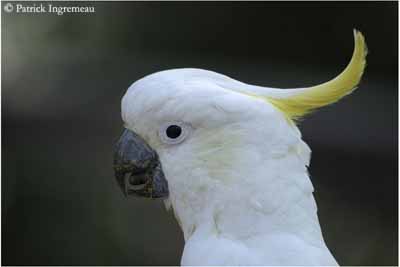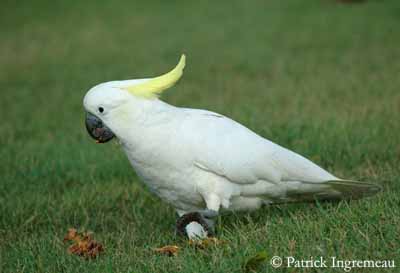
Sulphur-crested Cockatoo
Cacatua galerita
Psittaciforme Order – Cacatuidae Family
BIOMETRICS:
Length: 45 - 50 cm
Weight: 815 - 975 g
LONGEVITY: Up to 80 years
DESCRIPTION:
Sulphur-crested Cockatoo is one of the larger and more widespread of Australian Cockatoos.
Adult male is a large white parrot. It has yellow wash on underwings and undertail. Tail is relatively short.
On the white head, we can see long, conspicuous yellow crest. This crest is usually sleeked back, and the bird raises it when alarmed or excited. It has slight pale yellow patch on head sides, below the eyes. Eyes are dark brown, with fleshy white eye-ring. Hooked bill is black. Legs and feet are dark grey.
Female is similar, with red-brown eyes.
Juvenile resembles adults. Young reaches its sexual maturity at 5-6 years.
PROTECTION / THREATS / STATUS:
Sulphur-crested Cockatoo is a very popular cage-bird, but numerous birds escape and become pests in urban areas.
As many other parrots, Sulphur-crested Cockatoo is vulnerable to a widespread viral disease which causes the birds to lose their feathers and grow grotesquely shaped bills.
Sulphur-crested Cockatoos are considered a pest by farmers and can be shooted and poisoned.
However, this species is generally common.
Fr: Cacatoès à huppe jaune
All : Gelbhaubenkakadu
Esp : Cacatúa Galerita
Ital : Grande cacatua ciuffogiallo
Nd : Grote Geelkuifkaketoe
Russe : Желтохвостый Какаду
Photographs by Patrick Ingremeau
TAMANDUA
Text and picture of G.c.triton by Nicole Bouglouan
Sources:
HANDBOOK OF THE BIRDS OF THE WORLD volume 4 by Josep del Hoyo, Andrew Elliot and Jordi Sargatal – LYNX EDICION – ISBN 8487334229
PARROTS OF THE WORLD – An Identification Guide – by Joseph M. Forshaw – Princeton University Press – ISBN 0691092516
Birds in backyards (Birds Australia and Australian Museum)
New Zealand birds and birding (Narena Olliver)
Wikipedia (Wikipedia, The Free Encyclopedia)

Sulphur-crested Cockatoo has five subspecies:
C.g. galerita is white with suffused pale yellow on ear coverts and base of feathers of cheeks and throat. It lives in eastern and south-eastern Australia. Introduced to SW Australia and New Zealand.
C.g. queenslandica is smaller, with broader bill prominently ridged. It lives in Cape York Peninsula and southern Torres Strait Islands, north Queensland.
C.g. fitzroyi, with broader bill strongly ridged and pale blue eye-ring. It lives in northern Australia.
C.g. triton, has broader crest feathers and blue eye-ring. It lives in Western Papuan Islands, Indonesia and New Guinea.
C.g. eleonora has smaller bill and it is similar to C.g. triton. It lives in Aru Islands and Indonesia.
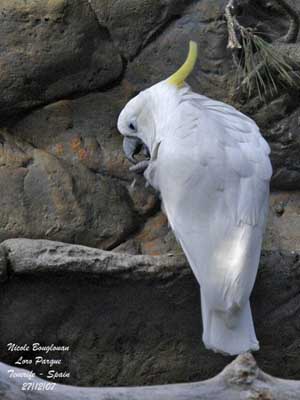
Cacatua galerita
triton
VOICE: SOUNDS BY XENO-CANTO
Sulphur-crested Cockatoo gives a raucous “raa-aach” in flight, or when perched on exposed branches. This call can be very loud. Alarm call is a series of abrupt, guttural screeches. They also utter some sharp squawk or shrill and dissyllabic whistle when feeding or preening. Sulphur-crested Cockatoo can mimic sounds of other animals, including humans.
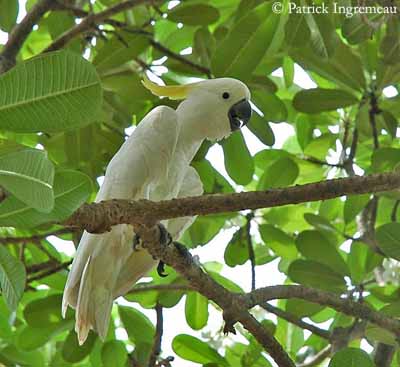
HABITAT:
Sulphur-crested Cockatoo lives in trees along streams, mainly in drier areas. They are found in wide variety of forests and woodlands, farmlands and plantations. It prefers forest edges or clearings, and their numbers are increasing in urban areas.
In New Guinea, it frequents forests, savannah woodlands and coastal mangroves.
They are resident all year-round in their range.
RANGE:
Sulphur-crested Cockatoo ranges in Australia, from Far North Queensland, to Adelaide and southern South Australia, and there is a local population in north of Perth, in SW Australia, and other in Hong Kong.
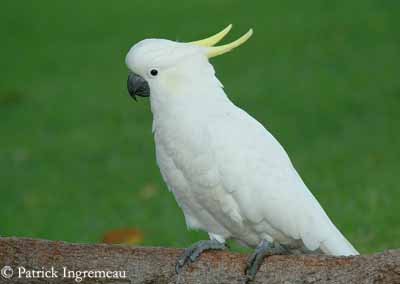
BEHAVIOUR:
Sulphur-crested Cockatoo is common in most part of its range. Outside of breeding season, these noisy birds gather in large feeding flocks in grasslands, bushes and trees. They feed on seeds, fruits, heart of palms and insects. Sulphur-crested Cockatoo can hold its food in one foot and breaks pieces off with the other foot.
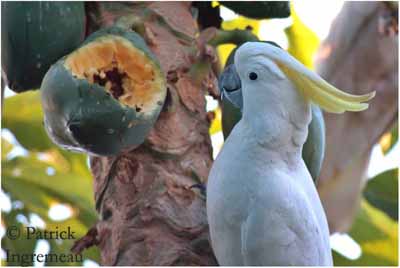
It is sometimes considered a pest for crops, and farmers shoot and poison them. While the flock is feeding on ground, several birds remain perched in nearby trees for watching for danger. If predator or intruder approaches, they utter loud, raucous calls.
They sleep in communal roosts, and return to it at dusk. Roost may contain several hundreds of birds.

During breeding season, Sulphur-crested Cockatoo is often seen in pairs or in small family groups. In the middle of the day, they shelter in shade in nearby trees, where they damage leaves and bark, causing defoliation to kill the tree.
Southern birds feed mainly on ground, whereas northern and New Guinean birds are mainly arboreal. They become common around human habitations where they are pests, using the powerful bill to destroy panelling on houses.
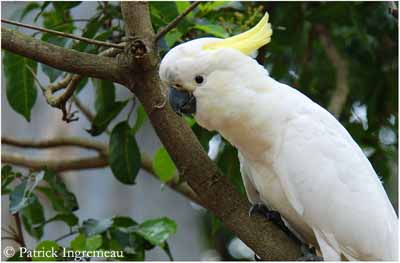
Courtship display is simple. Male struts along a branch towards female. It raises its crest, bobbing the head up and down, and from side to side, forming an “8”. At this moment, it utters soft chatter and both mates perform mutual preening and bill-touching.
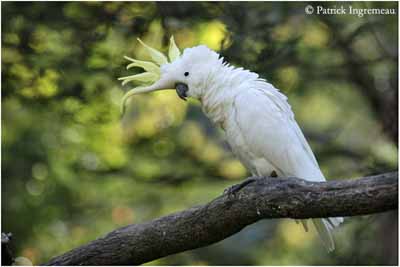
FLIGHT:
Sulphur-crested Cockatoo flies with rapid and shallow wing beats, interspersed with glides. It can fly at considerable height, gliding down in wide, sweeping circles to alight.
REPRODUCTION:
Breeding season occurs from August to January in the south, and from May to September in the north.
Sulphur-crested Cockatoo nests in hollow in tree, especially in tall Eucalypts, and usually near water. Both sexes prepare the nest. They are monogamous.
Female lays 1 to 3 white eggs. Incubation lasts about 30 days, shared by both parents. Altricial chicks are fed by both adults, and leave the nest about 60 to 70 days after hatching. They remain with their parents all year-round. Family groups can stay together for long time.

DIET:
Sulphur-crested Cockatoo feeds on berries, seeds, nuts and roots.
When not feeding, it bites off small branches and leaves from trees. It doesn’t eat them, but this action keeps the bill in perfect rim and avoids the bill growing too large.
